Bri a sent in this ad, found in Interview Magazine, and we’d like to know what you think of it:

It reminds me, somewhat, of this post featuring a billboard for Playstation with a black and white woman fighting.
Bri a sent in this ad, found in Interview Magazine, and we’d like to know what you think of it:

It reminds me, somewhat, of this post featuring a billboard for Playstation with a black and white woman fighting.
Toban B. sent in a link to UkraineDate, a website that lets men find hot Ukrainian women. Two images:


Of course, the site could be targeting men in any part of the world. However, it seems likely that it aims at men in wealthier nations in the West, particularly western Europe, the U.S., and Canada. Incidentally, these are the same regions that are the source of the vast majority of male sex tourists. Immigration from the Ukraine to the U.S. has also increased in the past decade; Ukraine is now in the top 10 nations of origin for immigrants to the U.S., with nearly 23,000 immigrants in 2005. And here in Vegas, the number of women from the Ukraine and Russia found to have been trafficked into the country and forced into prostitution (as well as those who came willingly to work in a range of jobs) is increasing. That’s a bit of rambling, but the point is, women from the former Soviet Union are marketed to men in the West in a number of ways.
As Toban points out, the dating site plays on the exotic qualities often attributed to Ukrainian and Russian women. Toban says, “the Ukranian women are presented as sex objects — and in accordance with certain standards of sex and beauty.” Certainly the site makes it clear that men aren’t supposed to to be interested in these women because of their intellect, personalities, or anything other than their beauty.
It’s a good example of the way that certain nationalities, races, ethnic groups, etc., are exoticized and portrayed as particularly attractive and sexual. In some cases, as with Asian women, part of the attraction is the stereotype that they are submissive and undemanding. I’m not certain, but I don’t think that particular stereotype is applied to Ukrainian and Russian women–in fact, I’ve seen them portrayed as high-maintenance and materialistic…but worth it because they’re hot.
Thanks, Toban!
NEW! Elizabeth C. let us know about a protest against sex tourism in Ukraine, which included slogans such as “Ukraine is not a brothel.”

They did so, however, by adopting PETA’s infamous tactic of using scantily-clad women, which may or may not have helped make their point.
The New York Times features an interactive graphic about the wage gap between men and women. It shows how different types of professions are distributed along the wage gap. At the website, you can see click on each dot to see wage gaps for specific professions (e.g., female professors make 22% less than male professors).
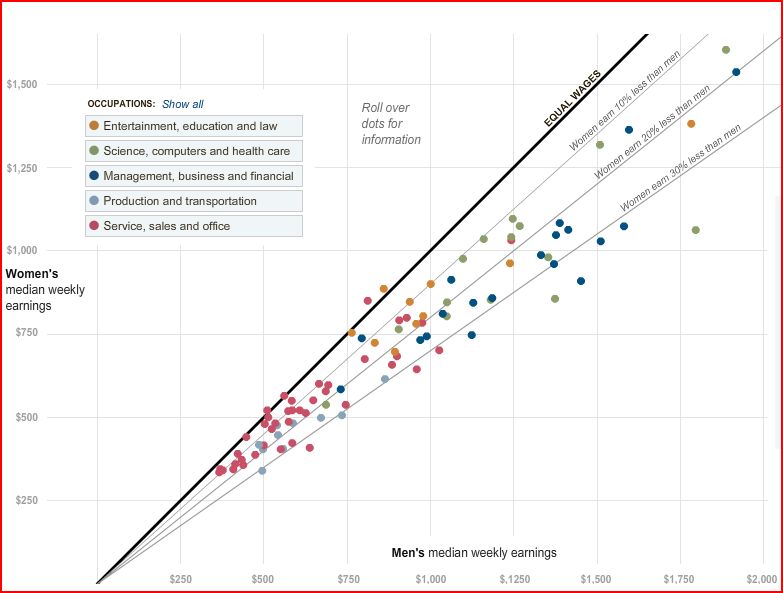
Also about the wage gap, see posts here, here, here, and here.
Those scamps at Patrón have come up with the following ad from their ” Some Perfection Is Debatable” campaign:
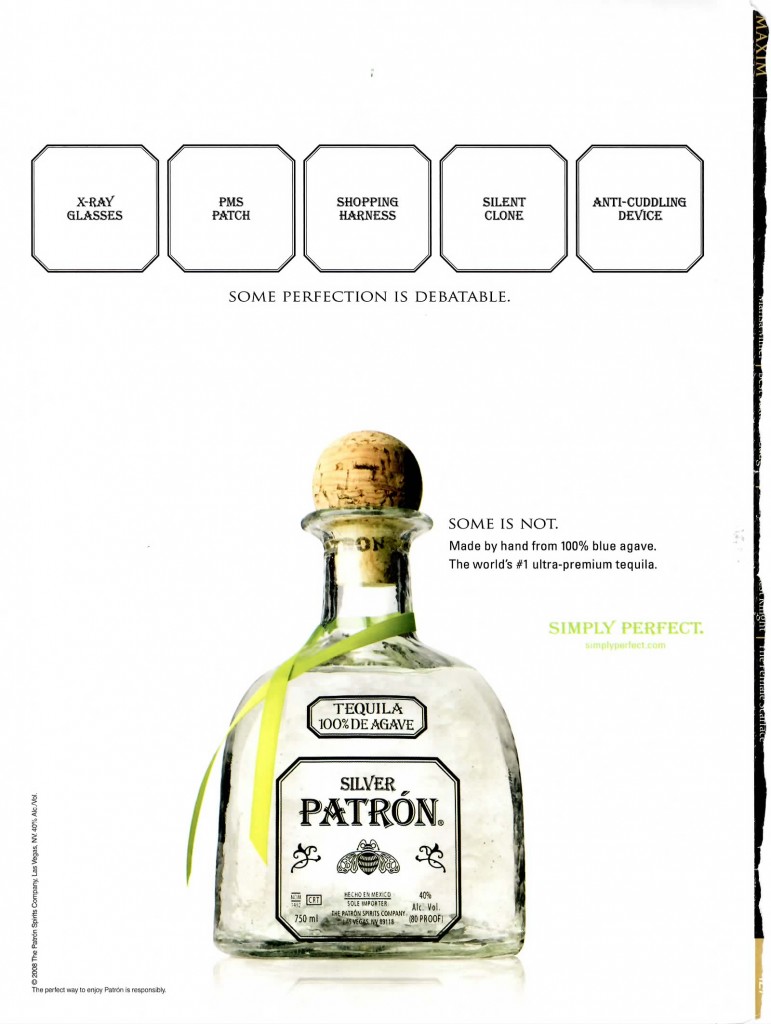
The following items apparently all represent perfection (debatably):
1. X-Ray Glasses: Dresses, locker rooms, bathroom stalls…the possibilities are limited only by your desire to look at the naked bodies of unconsenting women!
2. PMS Patch: Finally, a treatment for women whose behavior is intolerable because their hormonal levels are closest to men’s.
3. Shopping Harness: Presumably this would prevent shopping for girly stuff like purses and tampons. Buying video games and flat-screen TVs would be unaffected by the Harness. (When I pointed this out in class, a student told me “Women shop. Men purchase.”)
4. Silent Clone: At last, a woman who will only engage in sexual and domestic chores, without all of that troublesome talking!
5. Anti-Cuddling Device: Because after a rigorous, masculine bout of penile-vaginal intercourse, the last thing you want to do is something as gay as cuddling, am I right?
In addition to the obvious points the ad attempts to make about the inferiority of the feminine, it might be useful in a discussion about the smirking, elbow-in-the-ribs assumptions that are often a part of the enforcement of masculinity.
That’s the refrain anyway.
But whose sex is sold? And to who? If it was simply that sex sold, we’d see men and women equally sexually objectified in popular culture. Instead, we see, primarily, women sold to (presumably heterosexual) men. So what are we selling, exactly, if not “sex” We’re selling men’s sexual subjectivity and women as a sex object. That is, the idea that men’s desires are centrally important and meaningful, and women’s are not (because women are the object to men’s subjectivity).
That women’s object status and men’s subjectivity is sold to women in women’s magazines (for example, Cosmo and Glamour always feature scantily clad women on the cover) in no way undermines the idea that men’s sexual subjectivity is being sold. It’s just that it’s being sold to all of us.
For example, if this ad was selling Tango with sex, they’d both end up naked in the fourth frame, no?
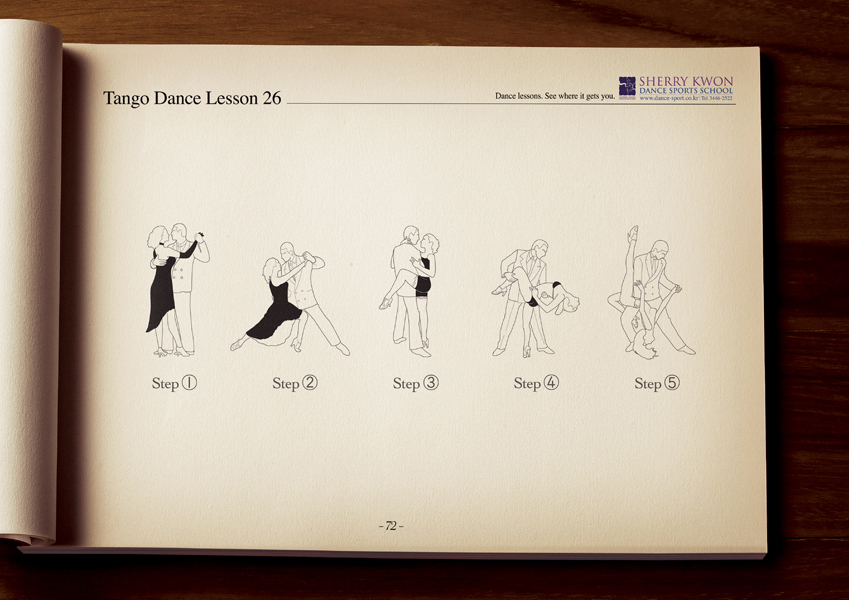
The new ad spots for M&Ms also illustrate this nicely. m&ms have been anthropomorphized in advertising for some time. There is only one female m&m and she is, by no accident, the green M&M. If you remember from elementary school, green is for horny. That, also, is no accident.
So male M&Ms come in multiple colors, flavors, shapes, and personalities, but female M&Ms are just sex objects.
In the Sports Illustrated Swimsuit Issue this year, M&Ms went with the theme (found here):
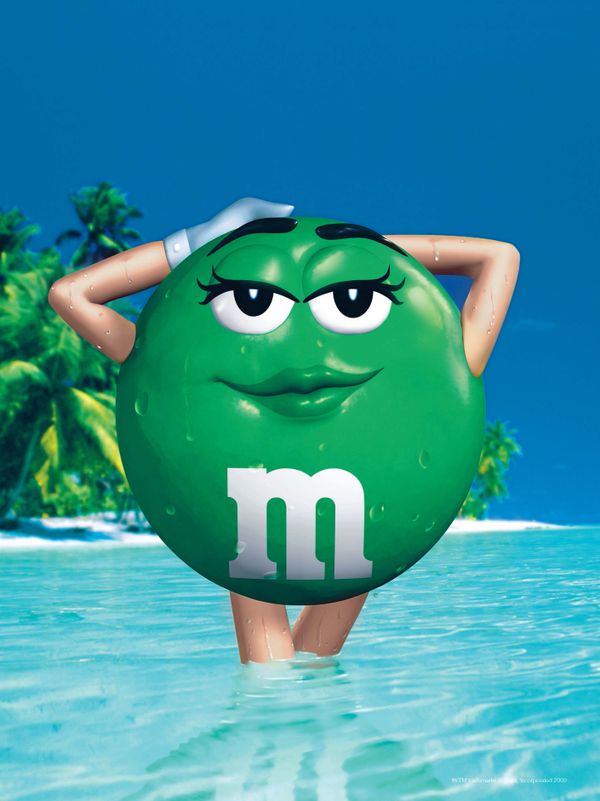

The ad campaign extended beyond Sports Illustrated:
[youtube]https://www.youtube.com/watch?v=LDoJNymbU1Q[/youtube]
[youtube]https://www.youtube.com/watch?v=ubChW7SLhKE[/youtube]
To sum, if it was simply “sex sells,” we’d see an even pattern of sexualization. But we don’t. More often than not, it is women who are sexualized. What is being sold, really, isn’t sex, but the legitimation and indulgence of (supposedly heterosexual) men’s sexual desires.
Kirsti M. alerted us to an M&M advertising campaign in Australia, where you could vote for your favorite color. All but one of the M&Ms are depicted as males (again, the female is Miss Green).
Here is a screenshot of the page for Red, a satirical take on a Marxist revolutionary:
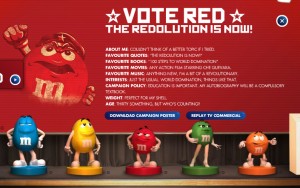
Some highlights from the text:
Favorite quotes: “The revolution is now!”
Favorite books: “100 Steps to World Domination”
Weight: “Perfect for my shell”
A poster:
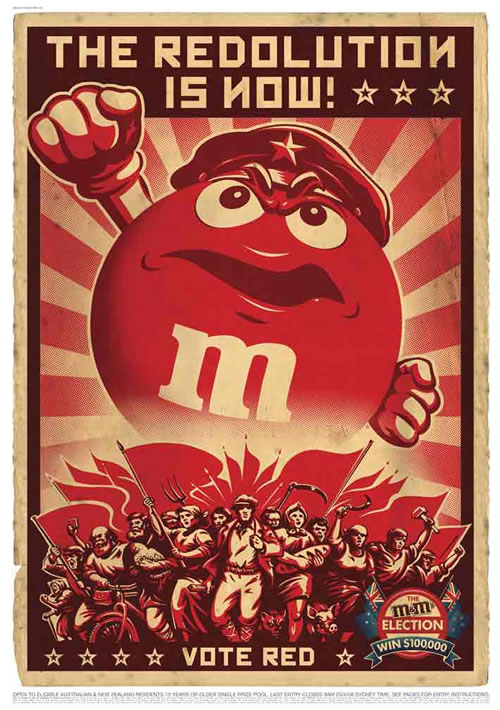
Here is a screenshot of the page for Miss Green (notice the others aren’t Mr. Blue or Mr. Red; only the female M&M has a title):
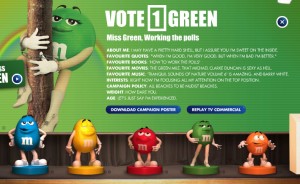
Highlights from the text:
Miss Green, working the polls.
About me: I may have a pretty hard shell, but I assure you I’m sweet on the inside.
Favorite quotes: “When I’m good, I’m very good, but when I’m bad I’m better.”
Favorite books: “How to Work the Polls”
Interests: Right now I’m focusing all my attention on the top position.
Campaign policy: All beaches to be nude beaches.
Age: Let’s just say I’m experienced.
A poster:
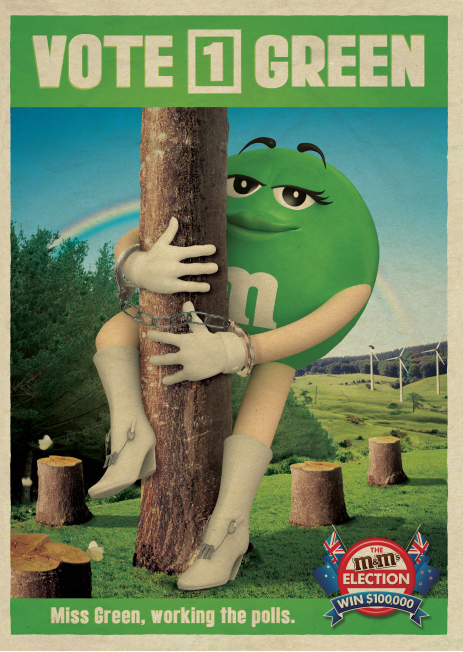
So again we see the sexualization of the female M&M (she’s “experienced,” focusing on the “top position,” she’s “working the polls” while wrapping her go-go-boot-clad legs around a tree in the manner of a stripper on a stripper pole, her arms and legs are much longer and thinner than the other M&Ms’ are).
In this vintage ad (1970s?), it is clear that it is his “plans” for her that are being appealed to:

NEW! These ads for hearing aids are apparently aimed at men only:


Other great examples include these posts with ads promoting organ donation, an air conditioning technical school, selling pasta, vegetarianism, aviation, cars, war, travel, dentistry, food, more food, houses, and mortgages. (To see the reverse dynamic, click here and here.)
Lisa Wade, PhD is an Associate Professor at Tulane University. She is the author of American Hookup, a book about college sexual culture; a textbook about gender; and a forthcoming introductory text: Terrible Magnificent Sociology. You can follow her on Twitter and Instagram.
A great example of how humor can be used to reveal the absurdity of certain social patterns that we take-for-granted:

“I can’t explain it,” said Nakajima, dressed in a pleated miniskirt and pure white knee socks. “There’s just something about American men who are at least twice my age and nearly three times my body weight that totally drives me wild.”
Added Nakajima, “They’re so hot.”
…
“I like it when they dress up like middle managers,” said Nakajima, twirling her girlish pigtails with one alabaster finger.
…
Drawn by her curiosity, Nakajima has scheduled a vacation to St. Louis for early March.
More at The Onion.
For a very real example of the flip side of this fetish, see this post on sex tourism in Thailand.
Pris S. sent in an ad that ran in the Collegiate Times, the Virginia Tech campus newspaper:

Of course, it’s a great example of advertising making people feel as though they aren’t sufficiently attractive so they’ll buy a product. But it’s also interesting because it’s an example of a cosmetic procedure that is increasingly marketed to men as well as women. Women do get laser hair removal, obviously, but so do men. Our standards of male attractiveness increasingly demand control of body hair. Hairy backs and shoulders are a source of ridicule. I have known several men who felt very self-conscious about their body hair, some of whom shaved or waxed some of it. Even chest hair is questionable; most images of shirtless men (in ads, pin-ups, calendars, etc.) show very little chest hair. The “man-0-lantern” chest-waxing scene in “The 40-Year-Old Virgin” of course used men’s concern about body hair for comedic effect.
The other thing that’s interesting here is the connection between having body hair (which, as far as I can tell from the ad, could include just about any type, including pubic hair) with being an “ape,” as though we should be ashamed of the fact that we are, in fact, mammals who have varying amounts of body hair. I suspect that it’s also part of the caveman stereotype–having lots of body hair is sort of associated with being less civilized, less fully human or modern. It’s also a beauty standard that is certainly going to be harder for some groups, those that tend to have more and/or darker body hair, to meet, which could bring up some interesting discussions about whose bodies are considered attractive, etc.
Thanks, Pris!
NEW: Andrea G. sent in a link to the line of Mangroomer products, which include electric shavers for back, nose/ear, and “private” hair:


These would be great for discussion new standards of male attractiveness–which increasingly pressure men to shave body and pubic hair, though not their legs or armpit hair, since that type of shaving is girly!–and also as an example of gendered marketing. Notice the very sciency-techy element to the website, with the graph-type lines in the background, the “swoosh” sounds, and so on.
Andrea also sent in this Nads commercial, in which we learn that the product saved a woman from a life of misery, since neighborhood children taunted her for having a beard:
It’s a great example of the social construction of bodies: we think it’s gross when women have beards, but at least in theory okay when men have them. Of course certain groups, such as Mormons, discourage men from growing beards, and in general full beards are relatively uncommon in the U.S. today and might be seen as unprofessional or otherwise inappropriate in some situations. But men usually won’t be openly mocked for growing hair on their faces (Joaquin Phoenix’s recent transformation aside), whereas for a woman, allowing hair to grow and be visible on her face would be socially unacceptable.
Thanks, Andrea!
To self-objectify is to think of yourself as an object first and a subject second. People who self-objectify often consider their appearance to be for others and work on their bodies and attractiveness in order to please/not offend an imagined other. Self-objectification is usually discussed in the context of women. It is suggested that these women take on the “male gaze,” looking at themselves through an imaginary male judge.
I found this ad in Maxim magazine. It encourages men to self-objectify by suggesting that they should think about how an imaginary female judge might evaluate their appearance (“She’s totally checking me out MILK Nutritional Shake”).
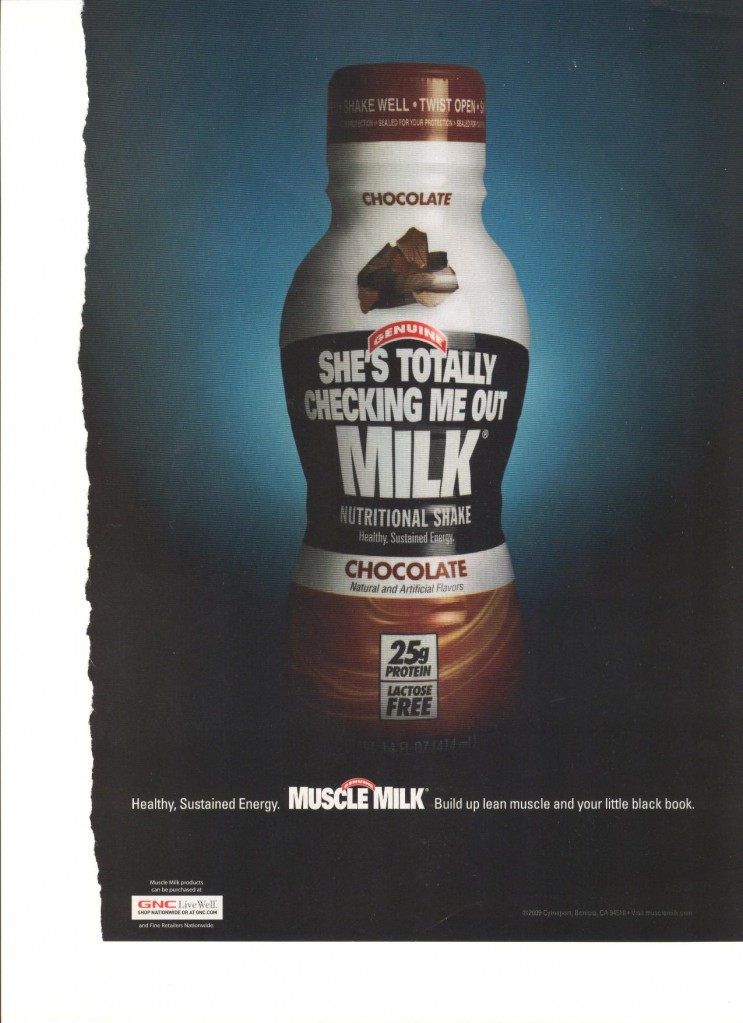 It’s fascinating that a magazine well-known for objectifying women also participates (at least in running this ad) in encouraging men to self-objectify. Without suggesting that women and men are equally objectified in American culture, I think it might be interesting to talk about the extent to which we live in an objectifying culture, period, and learn to self-objectify whether we are men or women.
It’s fascinating that a magazine well-known for objectifying women also participates (at least in running this ad) in encouraging men to self-objectify. Without suggesting that women and men are equally objectified in American culture, I think it might be interesting to talk about the extent to which we live in an objectifying culture, period, and learn to self-objectify whether we are men or women.